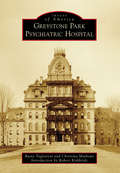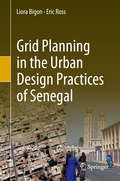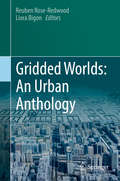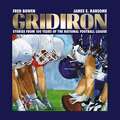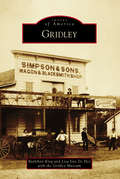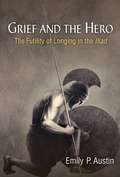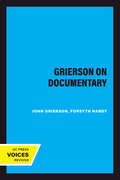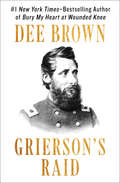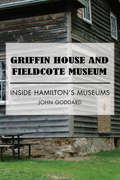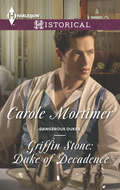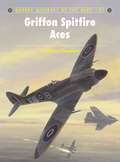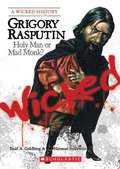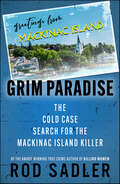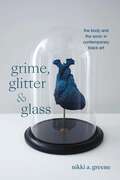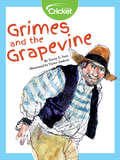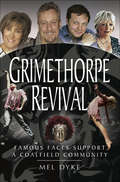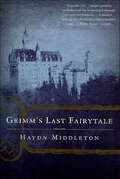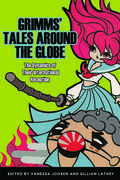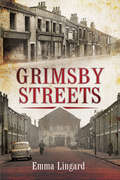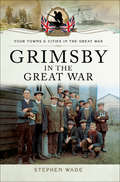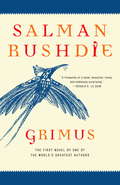- Table View
- List View
Greystone Park Psychiatric Hospital (Images of America)
by Christina Mathews Robert Kirkbride Rusty TagliareniThe Greystone Park Psychiatric Hospital was more than a building; it embodied an entire era of uniquely American history, from the unparalleled humanitarian efforts of Dorothea Dix to the revolutionary architectural concepts of Thomas Story Kirkbride. After well over a century of service, Greystone was left abandoned in 2008. From the time it closed until its demolition in 2015, Greystone became the focal point of a passionate preservation effort that drew national attention and served to spark the public's interest in historical asylum preservation. Many of the images contained in this book were rescued from the basement of Greystone in 2002 and have never been seen by the public. They appear courtesy of the Morris Plains Museum and its staff, who spent many hours digitally archiving the photographs so that future generations may better know Greystone's history.
Grid Planning in the Urban Design Practices of Senegal
by Liora Bigon Eric RossThis book is the first to trace the genealogy of an indigenous grid-pattern settlement design practice in Africa, and more specifically in Senegal. It does so by analyzing how the precolonial grid-plan design tradition of this country has become entangled with French colonial urban grid-planning, and with present-day, hybrid, planning cultures. By thus, it transcends the classic precolonial-colonial-postcolonial metahistorical divides.This properly illustrated book consists of five chapters, including an introductory chapter (historiography, theory and context) and a concluding chapter. The chapters’ text has both a chronological and thematic rationale, aimed at enhancing Islamic Studies by situating sub-Saharan Africa’s urbanism within mainstream research on the Muslim World; and at contributing directly to the wider project of de-Eurocentrizing urban planning history by developing a more inclusive, truly global, urban history.
Gridded Worlds: An Urban Anthology
by Liora Bigon Reuben Rose-RedwoodThis book is the first edited collection to bring together classic and contemporary writings on the urban grid in a single volume. The contributions showcased in this book examine the spatial histories of the grid from multiple perspectives in a variety of urban contexts. They explore the grid as both an indigenous urban form and a colonial imposition, a symbol of Confucian ideals and a spatial manifestation of the Protestant ethic, a replicable model for real estate speculation within capitalist societies and a spatial framework for the design of socialist cities. By examining the entangled histories of the grid, Gridded Worlds considers the variegated associations of gridded urban space with different political ideologies, economic systems, and cosmological orientations in comparative historical perspective. In doing so, this interdisciplinary anthology seeks to inspire new avenues of research on the past, present, and future of the gridded worlds of urban life. Gridded Worlds is primarily tailored to scholars working in the fields of urban history, world history, urban historical geography, architectural history, urban design, and the history of urban planning, and it will also be of interest to art historians, area studies scholars, and the urban studies community more generally.
Gridiron: Stories from 100 Years of the National Football League
by Fred BowenThis accessible, informative, and beautifully illustrated book celebrates the 100th anniversary of the NFL and is the perfect keepsake for football fans of all ages.The National Football League is the most popular sports league in the United States. Its championship game, the Super Bowl, is watched by millions of people every year. But it wasn&’t always like this. In the last one hundred years, football has changed from a poorly organized, often overlooked sport to America&’s favorite pastime. Here are the stories of that remarkable transformation. The stories of the greatest players, the most successful coaches, the most memorable games—and the amazing plays that made us gasp as we watched them in stadiums and on televisions all over America. Discover the league&’s scrappy beginnings in an automobile showroom, and early players like Red Grange, the Galloping Ghost. Relive the very first championship game, played indoors after a circus had visited, and famous games like the Ice Bowl. See the NFL at war, and meet some of the remarkable athletes who helped desegregate the league. Learn how the draft came into existence, and about the teams that strove for that almost impossible goal—a perfect season. Veteran sportswriter Fred Bowen brings his in-depth knowledge and lively prose to these fascinating stories, and award-winning artist James E. Ransome has created stunning full-page illustrations that bring the sport of football to life like never before.
Gridley
by Gridley Museum Lisa Van De Hey Ruthann KingTraveling from Galena, Illinois, George Washington Gridley was 32 years old when he first gazed upon a broad verdant valley in California in 1850. He looked northward from the top of the buttes and knew at once that he had found his future home. Gridley settled four miles north of the buttes and began to establish the agricultural empire that was to become his monument. In partnership with the California & Oregon Railroad, Gridley requested the railroad consider building a station at the tracks for farmers and ranchers to ship their livestock and produce. The town of Gridley was established with the building of the train station, along with an added park area donated by the railroad.
Grief and Women Writers in the English Renaissance
by Elizabeth HodgsonGrief and Women Writers in the English Renaissance anatomizes the era's powerful but troubling links between the forgettable dead and the living mourners who are implicated in the same oblivion. Four major women writers from 1570 to 1670 construct these difficult bonds between the spectral dead and the liminal mourner. Mary Sidney Herbert, Countess of Pembroke, reinvents the controversial substitutions of aristocratic funerals . New Protestant ideologies of the sainted dead connect devotional mourning and patronage in Aemelia Lanyer's writing. Mary Wroth's verse enacts a uniquely exalted, imaginative melancholy in which Jacobean subjects dissolve into their mourning artifacts. Among the precarious political mourners of the later half of the period , Katherine Philips's lyric verse plays the shell game of private grief. Forgetting, being forgotten, and being dead are risks that the dead and the living ironically share in these central texts by the English Renaissance's most illustrious women writers.
Grief and the Hero: The Futility of Longing in the Iliad
by Emily P. AustinGrief and the Hero examines Achilles’ experience of the futility of grief in the context of the Iliad’s study of anger. No action can undo his friend Patroklos’ death, but the experience of death drives him to behave as though he can achieve something restorative. Rather than assuming that grief gives rise to anger, as most scholars have done, Grief and the Hero pays close attention to the poem’s representation of the origin of these emotions. In the Iliad, only Achilles’ grief for Patroklos is joined with the word pothê, “longing”; no other grief in the poem is described with this term. The Iliad depicts Achilles’ grief as the rupture of shared life—an insight that generates a new way of reading the epic. Achilles’ anguish drives him to extremes, oscillating between self-isolation and seeking communal expressions of grief; between weeping abundantly and relentlessly pursuing battle; between varied threats of mutilation, deeds of vengeance, and other vows. Yet his yearning for life shared with Patroklos is the common denominator. Here lies the profound insight of the Iliad. All of Achilles’ grief-driven deeds arise from his longing for life with Patroklos, and thus all of these deeds are, in a deep sense, futile. He yearns for something unattainable—undoing the reality of death. Grief and the Hero will appeal not only to scholars and students of Homer but to all humanists. Loss, longing, and even revenge touch many human lives, and the insights of the Iliad have broad resonance.
Grief and the Shaping of Muslim Communities in North India, c. 1857–1940s
by Eve TignolDrawing on approaches from the history of emotions, Eve Tignol investigates how they were collectively cultivated and debated for the shaping of Muslim community identity and for political mobilisation in north India in the wake of the Uprising of 1857 until the 1940s. Utilising a rich corpus of Urdu sources evoking the past, including newspapers, colonial records, pamphlets, novels, letters, essays and poetry, she explores the ways in which writing took on a particular significance for Muslim elites in North India during this period. Uncovering different episodes in the history of British India as vignettes, she highlights a multiplicity of emotional styles and of memory works, and their controversial nature. The book demonstrates the significance of grief as a proactive tool in creating solidarities and deepens our understanding of the dynamics behind collective action in colonial north India.
Grierson on Documentary
by John GriersonThis title is part of UC Press's Voices Revived program, which commemorates University of California Press’s mission to seek out and cultivate the brightest minds and give them voice, reach, and impact. Drawing on a backlist dating to 1893, Voices Revived makes high-quality, peer-reviewed scholarship accessible once again using print-on-demand technology. This title was originally published in 1966.
Grierson's Raid: A Cavalry Adventure Of The Civil War
by Dee BrownThe improbable Civil War raid that led to the Siege of Vicksburg, recounted by the #1 New York Times–bestselling author of Bury My Heart at Wounded Knee. For two weeks in the spring of 1862, Colonel Benjamin Grierson and 1,700 Union cavalry troopers conducted a raid from Tennessee to Louisiana. It was intended to divert Confederate attention from Ulysses S. Grant&’s army crossing the Mississippi River, a maneuver that would set the stage for the Siege of Vicksburg. Led by a former music teacher whose role in the Union cavalry was belied by his hatred of horses, Grierson&’s Raid was not only brilliant, but improbably successful. The cavalrymen ripped up railway track, destroyed storehouses, took prisoners, and freed slaves. Colonel Grierson lost only three men through the whole expedition. Rich and detailed, Grierson&’s Raid is the definitive work on one of the most astonishing missions of the Civil War&’s early days. This ebook features an illustrated biography of Dee Brown including rare photos from the author&’s personal collection.
Griffin House and Fieldcote Museum: Inside Hamilton's Museums
by John GoddardInside Hamilton’s Museums helps to satisfy a growing curiosity about Canada’s steel capital as it evolves into a post-industrial city and cultural destination. In this special excerpt we visit two sites, Griffin House and the Fieldcote Memorial Park and Museum. Griffin House honours one of Ancaster's earliest black settlers, Enerals Griffin, and pays tribute to the black slaves from the United States who fled to freedom in Upper Canada. Fieldcote Museum was built as private home and now functions as a gallery for exhibitions alternating between local history and the visual arts. John Goddard takes us on a detailed tour of the historic homes and gardens, providing fascinating historical background and insight.
Griffin Stone: Duke of Decadence
by Carole MortimerWho: Griffin Stone, tenth Duke of Rotherham. What: A disheveled woman who is nearly trampled by his carriage horses. When: Late one summer night while the Duke is in pursuit of would-be assassins. Why: When the mysterious beauty's identity is revealed as Lady Beatrix Stanton, Griffin realizes it's she who holds the key to everything. Bea's memory must be unlocked, but with every second in her presence inflaming Griffin's desire, keeping his mind on the task ahead proves nigh on impossible!
Griffon Spitfire Aces
by Chris Davey Andrew ThomasModified for low-level operations to counter Luftwaffe attacks on the south coast, the Griffon-powered Spitfire XIV became the best low-level fighter ofWorld War 2. Squadrons moved to southeastern England to counter the V1 flying bomb offensive, and daring pilots tipped the V1 over with the aircraft's wingtip to disorientate the bomb and became "doodlebug aces." Andrew Thomas also investigates the role played by the modified Spitfire squadrons after the V1 offensive, both in the attack on Germany and after the war in Malaya and Palestine. First-hand stories, photographs and color profiles complete this account of the aces who flew the most powerful Spitfire variant ever built.
Grigory Rasputin
by Enid A. Goldberg Norman ItzkowitzBiography of Rasputin, courtier in the court of Nicholas II, for teens.
Grim Expectations
by Kw JeterA mind-boggling new sequel to Infernal Devices to celebrate thirty years of Steampunk.Some time after the events of Fiendish Schemes, George Dower finds himself a widower, of sorts. On her deathbed, Miss McThane entrusts Dower with a small, ticking clockwork box. The box is mysteriously linked to her. When she breathes her last, the box stops ticking and Dower is able to open it, to find hundreds of letters – written in an unknown hand, signed only with the initial S. They’re not love letters, but refer instead to the letter-writer’s ongoing search for some other person. The last is a simple note, reading “Found him”…File Under: Fantasy
Grim Paradise: The Cold Case Search for the Mackinac Island Killer
by Rod SadlerThe true crime story of a 1960 murder that rocked a tranquil Michigan vacation spot and the search for justice that followed.When widow Frances Lacey was murdered in July 1960 on Mackinac Island, only a few meager clues were found by police, and the case soon turned cold. But more than sixty years later, will those same clues finally solve the mystery? On July 24, 1960, the quaint charm and serenity of Mackinac, nestled between Michigan’s Upper and Lower Peninsulas, was shattered by Lacey’s brutal death. Despite a massive manhunt and thousands of pages of police reports, her killer was never caught. Now, in Grim Paradise, true crime author Rod Sadler (Killing Women) delves into the secrets of one of Michigan's most perplexing murder cases. Offering an in-depth and suspenseful account of the long-standing mystery, he poses the question: Could advancements in DNA technology lead to the identity of the Mackinac Island murderer as it did in the case of the Golden State Killer?
Grime, Glitter, and Glass: The Body and the Sonic in Contemporary Black Art (The Visual Arts of Africa and its Diasporas)
by Nikki A. GreeneIn Grime, Glitter, and Glass, Nikki A. Greene examines how contemporary Black visual artists use sonic elements to refigure the formal and philosophical developments of Black art and culture. Focusing on the multimedia art of Renée Stout, Radcliffe Bailey, and María Magdalena Campos-Pons, Greene traces the intersection of the visual’s sonic possibilities with the Black body’s physical, representational, and metaphorical use in art. She employs her concept of “visual aesthetic musicality” to interpret Black visual art by examining the musical genres of jazz and rap, along with the often-overlooked innovations of funk and rumba, within art historiography. From Bailey’s use of multilayered surfaces of glitter, mud, and recycled materials to meditate on Sun Ra’s Afrofuturism to Stout’s life-size cast of her own body that recalls funk musician Betty Davis to Campos-Pons’s performative and sculptural references to sugar that resonate with the legacy of Celia Cruz, Greene outlines how these artists use mediums such as molded glass sculptures, viscous wet plaster, and dazzling mannequin heads to enhance the manifestations of Black identity. By foregrounding the sonic elements of their work, Greene demonstrates that these artists use sound to make themselves legible, recognizable, and audible.
Grimes and the Grapevine
by Tracey E. FernConfederate Major Absalom Grimes carried letters between Civil War soldiers and their families, and became an expert prison escape artist in the process. Read about Grimes' amazing life of adventure in this historical nonfiction story.
Grimethorpe Revival: Celebrity Support for a Coalfield Community
by Mel DykeThis is a unique archive of childrens hopes, fears, views and memories during times when political shifts affected and risked educational potential, performance and aspiration. When career prospects for girls were equally at risk in mining dominated areas it reveals how a creative counter movement in a coalfield community during the bleak days of the 1990s pit closures was strengthened and supported by a namedropping backlash of heartening support wiping out boundaries of class or political slant. The outcome then was positively motivated youngsters, with some remarkable and diverse results right up to the present day.
Grimm's Last Fairytale: A Novel
by Haydn MiddletonIn September 1863 Jacob Grimm travels through rural western Germany with his devoted niece, Auguste-- who longs to learn, at last, the truth about her family-- and Kummel, their new and enigmatic manservant. As relations between the three reach the boiling point, Jacob's traumas and heartbreaks here in his original homeland are revealed in vivid flashbacks. Now, old, Jacob resists Auguste's attempts to make him take stock of his life, but memories that are repressed have a tendency to reappear in other places and in other guises.Throughout Jacob's travels, he is reminded of the folk tales he and his brother Wilhelm collected in their Tales for the Young and Old. Although the brothers were renowned language scholars and passionate supporters of German unification, they were haunted throughout their lives by the Tales. Most notable is the feverish fairy tale of Sleeping Beauty, which holds a shattered mirror to a life, a country, and a history. The Sleeping Beauty recounted here is neither the Disney version nor even the Grimms' version, but an enchanting tale that goes beyond the marriage of the prince and princess to reveal the surprising truth behind the evil spell.In his compelling historical novel, Grimm's Last Fairytale, Haydn Middleton re-creates the life story of literature's most famous brothers. It is a history that could almost be a fairy tale itself, with its fabulous changes of fortune, tests of duty and honor, arrogant princes, lost loves, and twisted family relationships-- all unfolding in a world of dark forests and even darker politics.
Grimms' Tales around the Globe: The Dynamics of Their International Reception
by Vanessa Joosen Gillian LatheyGrimms' fairy tales are among the best-known stories in the world, but the way they have been introduced into and interpreted by cultures across the globe has varied enormously. In Grimms' Tales around the Globe, editors Vanessa Joosen and Gillian Lathey bring together scholars from Asia, Europe, and North and Latin America to investigate the international reception of the Grimms' tales. The essays in this volume offer insights into the social and literary role of the tales in a number of countries and languages, finding aspects that are internationally constant as well as locally particular. In the first section, Cultural Resistance and Assimilation, contributors consider the global history of the reception of the Grimms' tales in a range of cultures. In these eight chapters, scholars explore how cunning translators and daring publishers around the world reshaped and rewrote the tales, incorporating them into existing fairy-tale traditions, inspiring new writings, and often introducing new uncertainties of meaning into the already ambiguous stories. Contributors in the second part, Reframings, Paratexts, and Multimedia Translations, shed light on how the Grimms' tales were affected by intermedial adaptation when traveling abroad. These six chapters focus on illustrations, manga, and film and television adaptations. In all, contributors take a wide view of the tales' history in a range of locales--including Poland, China, Croatia, India, Japan, and France. Grimms' Tales around the Globe shows that the tales, with their paradox between the universal and the local and their long and world-spanning translation history, form a unique and exciting corpus for the study of reception. Fairy-tale and folklore scholars as well as readers interested in literary history and translation will appreciate this enlightening volume.
Grimsby Streets
by Emma LingardA &“fascinating&” walk through the history of one English port town, told through the names of its streets—includes photos (Books Monthly). With a history that dates back to the days of the Vikings, Grimsby, on England&’s eastern coast, has served as a hub for shipping companies and fishermen and a home to generations of citizens. Arranged alphabetically, Grimsby Streets is a journey through time, examining the meanings and origins of many of the town&’s street names, from their association with the Danish settlers through to the Victorian era and the men who helped develop the town and build its surrounding docks. Names of the great and good who were forgotten until now are explored, as well as some of the many famous people who were born there, and where they lived. The book also covers numerous incidents that occurred on Grimsby's streets, providing colorful insight into the history of this once-famous fishing port and some of the many wonderful buildings that stood there. Included throughout are a selection of old photographs, some of which have never been published before, a reminder of what this town was like before change and demolition in the 1960s.
Grimsby in the Great War (Your Towns & Cities in the Great War)
by Stephen WadeGrimsby in the Great War is a detailed account of how the experience of war impacted on the seaside town of Grimsby from the outbreak of the Great War in 1914, to the long-awaited peace of 1918.Grimsby and Cleethorpes were among the most vulnerable and exposed British towns in August 1914 when the Great War broke out. Situated on the North Sea, and facing the German Baltic fleet, their vessels were to face the mines and the U-boat torpedoes as the war progressed. But this is merely one of the incredibly dramatic and testing developments in the wartime saga of 1914-18, which impacted on the the town of Grimsby. Written into the greater story are the achievements of the Grimsby Chums and the other regiments containing Grimsby men, and the amazing story of the Home Front experience, from the local shell factory staffed largely by women, to the War Hospital Supply Depot and the Womens Emergency Corps.Throughout this compelling book, Stephen Wade documents the town's remarkable stories of heroism, determination and resolution in the face of the immensity of the war and its seemingly endless tests and trials of Grimsby's mettle.
Grimus: A Novel
by Salman Rushdie“A mixture of science fiction and folktale, past and future, primitive and present-day . . . Thunderous and touching.”–Financial TimesAfter drinking an elixir that bestows immortality upon him, a young Indian named Flapping Eagle spends the next seven hundred years sailing the seas with the blessing–and ultimately the burden–of living forever. Eventually, weary of the sameness of life, he journeys to the mountainous Calf Island to regain his mortality. There he meets other immortals obsessed with their own stasis and sets out to scale the island’s peak, from which the mysterious and corrosive Grimus Effect emits. Through a series of thrilling quests and encounters, Flapping Eagle comes face-to-face with the island’s creator and unwinds the mysteries of his own humanity. Salman Rushdie’s celebrated debut novel remains as powerful and as haunting as when it was first published more than thirty years ago.“A book to be read twice . . . [Grimus] is literate, it is fun, it is meaningful, and perhaps most important, it pushes the boundaries of the form outward.”–Los Angeles Times
Grinding It Out: The Making of McDonald's
by Ray Kroc"He either enchants or antagonizes everyone he meets. But even his enemies agree there are three things Ray Kroc does damned well: sell hamburgers, make money, and tell stories." --from Grinding It OutFew entrepreneurs can claim to have radically changed the way we live, and Ray Kroc is one of them. His revolutions in food-service automation, franchising, shared national training, and advertising have earned him a place beside the men and women who have founded not only businesses, but entire empires. But even more interesting than Ray Kroc the business man is Ray Kroc the man. Not your typical self-made tycoon, Kroc was fifty-two years old when he opened his first franchise. In Grinding It Out, you'll meet the man behind McDonald's, one of the largest fast-food corporations in the world with over 32,000 stores around the globe.Irrepressible enthusiast, intuitive people person, and born storyteller, Kroc will fascinate and inspire you on every page.
